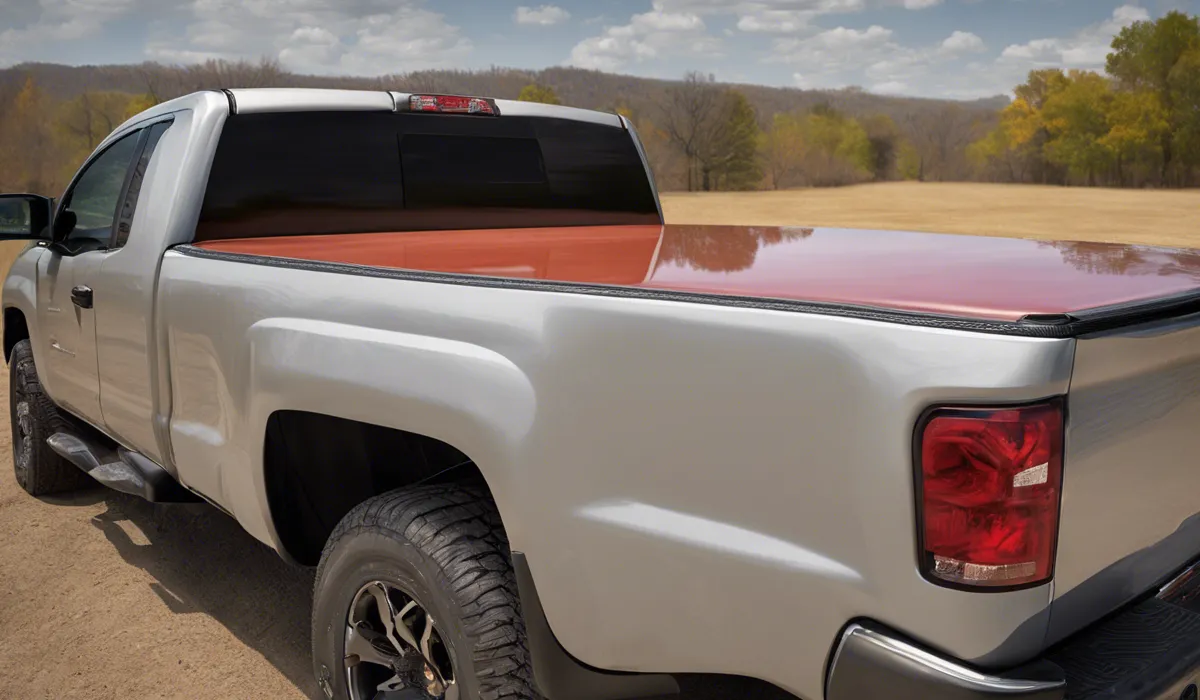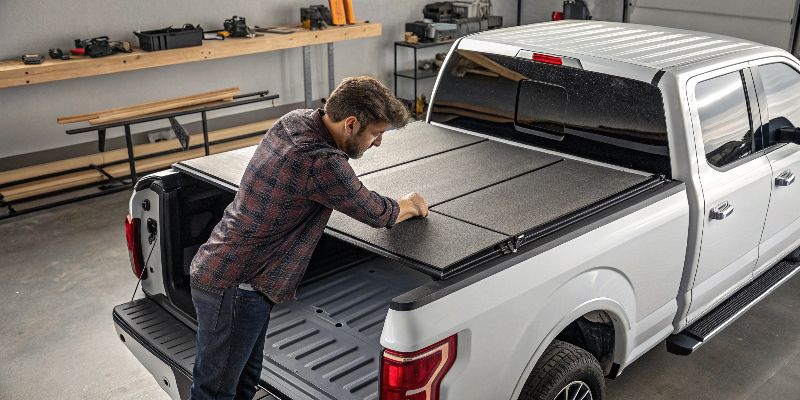To build a fiberglass tonneau cover, create a frame mold of your truck bed, apply a gel coat, then lay fiberglass sheets with resin. Once cured, remove the cover, trim the edges, and install hardware for mounting on the truck bed.
Understanding Fiberglass Tonneau Cover Basics

Definition of Tonneau Cover
A tonneau cover is a hard or soft cover that fits over the bed of a pickup truck to protect cargo from weather elements and improve the vehicle’s aerodynamics.
It’s a critical accessory for truck owners who want to secure items or enhance their truck’s appearance.
Benefits of Using Fiberglass
Fiberglass is a popular material for tonneau covers due to its strength, durability, and lightweight properties.
It’s resistant to rust and corrosion, offers excellent structural integrity, and can be shaped to fit the contours of any truck bed.
Fiberglass tonneau covers are also known for their paintability, allowing for a seamless match with the truck’s color.
Tools and Materials Needed for the Project
Before starting your project, gather the necessary tools and materials.
You’ll need fiberglass sheets, resin, hardener, a gel coat, a mold release agent, sandpaper, a measuring tape, a mixer, brushes, a roller, and safety equipment like gloves and goggles.
Select quality materials to ensure durability and a professional finish for your tonneau cover.
Step-by-Step Guide on Building Your Fiberglass Tonneau Cover

Preparing the Truck Bed
Cleaning the Area
Begin by thoroughly cleaning the truck bed. Remove any debris, dust, or grease to ensure a clean working surface.
Wash the area with soap and water, then use a degreaser for any stubborn spots. Allow the bed to dry completely before proceeding to the next steps.
Taking Measurements
Accurate measurements are crucial for a snug-fitting tonneau cover.
Measure the length, width, and height of the truck bed, making note of any unique features or contours.
These measurements will guide you in creating the mold or frame for your cover.
Creating a Mold or Frame
Design Considerations
Design your tonneau cover to complement the shape and size of your truck bed.
Consider how the cover will open and close, and how it will integrate with the truck’s overall aesthetics.
Sketch out your design to visualize the end result and to aid in the construction process.
Constructing the Frame
Using the measurements taken earlier, construct a sturdy frame to serve as the base of your mold.
Use materials like wood or foam that can be easily shaped and secured.
Ensure the frame is level and matches the contours of your truck bed for an accurate mold.
Applying the Fiberglass
Mixing the Resin
Mix the fiberglass resin with a hardener according to the manufacturer’s instructions.
Achieving the correct ratio is essential for the resin to cure properly. Once mixed, work quickly to apply the resin before it begins to harden.
Laying the Fiberglass Sheets
Cut the fiberglass sheets to size and lay them over the frame.
Brush the mixed resin onto the sheets, ensuring they are fully saturated.
Smooth out any air bubbles and wrinkles with a roller for a consistent layer. Overlap sheets for added strength.
Drying and Curing Process
Allow the fiberglass to dry and cure completely, which may take several hours or overnight.
A properly cured fiberglass cover will be hard and sturdy.
Ensure the cover is not disturbed during this time to prevent any deformities or weak spots.
Adding Structural Reinforcement
Strengthening Edges and Corners
Edges and corners are high-stress areas and need additional reinforcement.
Apply extra layers of fiberglass and resin to these areas, ensuring they are robust enough to handle daily use and the stresses of opening and closing the cover.
Applying Additional Layers if Necessary
If the initial layers of fiberglass do not provide enough strength, apply additional layers.
Each layer should be applied with fresh resin and allowed to cure fully before the next is added. This step is crucial for a long-lasting tonneau cover.
Finishing Touches
Sanding for Smoothness
Once the fiberglass is cured, sand the surface with coarse sandpaper to remove any imperfections.
Gradually use finer sandpaper until the cover is smooth to the touch. A smooth surface is essential for a professional-looking finish.
Painting or Gel Coating
Paint or gel coat the tonneau cover to protect it from the elements and to match the truck’s color.
Apply multiple thin layers, allowing each to dry before adding the next. A well-applied finish will enhance the cover’s appearance and longevity.
Installing Support Hardware
Install the necessary hardware, such as hinges and locks, to attach the cover to the truck bed.
Ensure that all hardware is properly aligned and secure for smooth operation and to prevent any rattling or movement while driving.
Installation and Maintenance Tips for Your Fiberglass Tonneau Cover

Mounting the Cover onto the Truck
Positioning and Securing the Cover
Position the tonneau cover on the truck bed and align it with the bed’s edges.
Secure the cover with the installed hardware, checking for a snug fit.
Adjustment may be necessary to ensure the cover opens and closes properly without gaps or misalignment.
Sealing for Weatherproofing
Apply a weatherproof seal around the edges of the tonneau cover to prevent water or moisture from entering the truck bed.
A good seal will protect your cargo from the elements and increase the cover’s effectiveness.
Maintenance Recommendations
Regular Cleaning and Waxing
Maintain your fiberglass tonneau cover by cleaning it regularly with mild soap and water.
Wax the cover periodically to preserve the finish and protect it from UV rays, which can cause fading and deterioration over time.
Inspecting for Wear and Tear
Regularly inspect your tonneau cover for signs of wear and tear, such as cracks or scratches.
Early detection of issues can prevent more significant problems and extend the life of your cover.
Troubleshooting Common Issues
Adjusting Fit and Alignment
If your tonneau cover is not fitting correctly or is misaligned, adjust the mounting hardware.
Proper alignment ensures smooth operation and a secure fit, preventing potential damage to the cover or truck bed.
Repairing Minor Cracks or Scratches
For minor cracks or scratches, use a fiberglass repair kit to fill and seal the damage.
Follow the manufacturer’s instructions for the best results, and sand the repaired area to match the surrounding surface.
FAQs About Building a Fiberglass Tonneau Cover
What materials are needed to build a fiberglass tonneau cover?
To build a fiberglass tonneau cover, you will need a frame mold of your truck bed, a gel coat, fiberglass sheets, resin, and hardware for mounting on the truck bed.
How do you create a frame mold for a fiberglass tonneau cover?
To create a frame mold for a fiberglass tonneau cover, measure your truck bed accurately and construct a form that mimics its shape and size, often from wood or foam.
What is the purpose of applying a gel coat when building a tonneau cover?
The gel coat is applied to create a smooth, high-quality finish on the surface of the fiberglass tonneau cover and to protect the fiberglass layers beneath.
How long does it take for a fiberglass tonneau cover to cure?
The curing time for a fiberglass tonneau cover can vary but generally takes several hours to a full day, depending on the resin used, temperature, and humidity conditions.
What kind of hardware is required to mount a fiberglass tonneau cover on a truck bed?
To mount a fiberglass tonneau cover on a truck bed, you’ll generally need hinges, latches, and possibly struts or supports, along with appropriate fasteners such as screws or bolts.
Final Thoughts
Building a custom fiberglass tonneau cover involves sculpting a frame mold tailored to the truck bed, applying a protective gel coat, and laying fiberglass sheets with resin.
After the material cures, the cover is removed, the edges are trimmed for a perfect fit, and the necessary mounting hardware is installed to secure the cover to the truck bed effectively.
